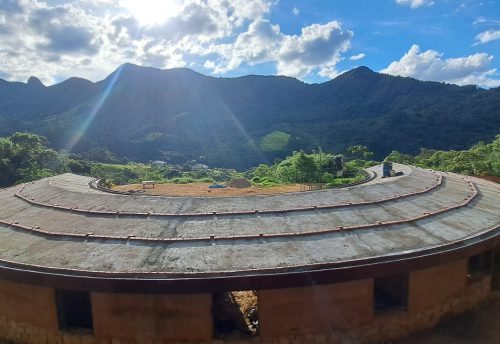
Here at Eco Caminhos, we use a lot of cob. But what exactly is cob?
Cob is a natural building (bioconstruction) technique consisting of clay, sand, and straw which is all mixed together with some water. As an earthen construction, it has a very low environmental impact, can be made with locally sourced – even onsite – materials, and results in BEAUTIFUL builds!
The term cob comes from medieval England. As a building technique, however, cob has been developed independently by various cultures from all around the world since ancient times. Some of the world’s oldest structures were made with cob and many have survived to this day because of how durable the structures are! Because of this long and multicultural history, it is important to note that cob also goes by many other names (like adobe). More recently, cob construction enjoyed a revival in Europe and the US during the 1970s because of its superior durability and sustainability in comparison to modern building techniques.
Making cob is pretty simple, too. You mix clay, sand, and straw with water to form a homogeneous and plastic mass. Taking chunks of this mass and stacking them on top of one another allows us to lift walls for homes and buildings. You could also build a variety of other structures like furniture and ovens! Cob, once dry, resembles concrete and is very hard and sturdy.
Cob’s moldability allows us to build almost any form in a variety of styles, so it should be no surprise why it has become so popular in natural building (bioconstruction). From traditional homes with straight walls, to unconventional and alternative styles with curves and domes, cob can do it all!
It can also be used in conjunction with other materials and building techniques. One example is wattle and daub, where walls are made by filling and covering a bamboo framework with cob. Some other examples include cob walls made with reused glass or plastic bottles fitted into them, and frame and furniture inlays made of the same mixture.
Despite its simplicity, cob as a construction technique is extremely safe, durable, sustainable, and capable of creating comfortable living environments for us. Due to its earthen properties, thick cob walls offer great thermal insulation and reduce indoor humidity which, in turn, reduces energy consumption for heating and cooling.
Naturally built cob homes are wonderful, for they give us the freedom to build whatever we like, can be integrated into the surrounding landscape, are sustainable and environmentally friendly, and even surpass conventional construction techniques on several fronts. Check out some of our cob-based projects here and see for yourself!
![[:en]Eco Caminhos: Permaculture & Agroforestry Farm in Brazil[:br]Eco Caminhos: Fazenda de Permacultura e Agrofloresta no Brasil[:sp]Permacultura y Agroforestería en Brasil: Eco Caminhos[:]](https://ecocaminhos.com/wp-content/uploads/2024/02/Eco-Caminhos-logo-without-border.png)

 Português
Português Español
Español


